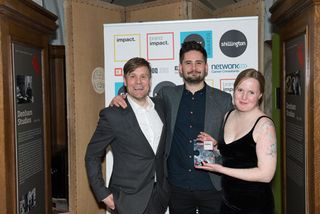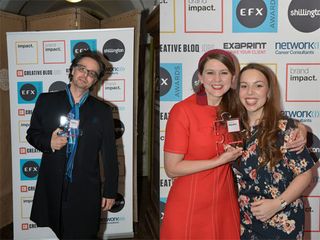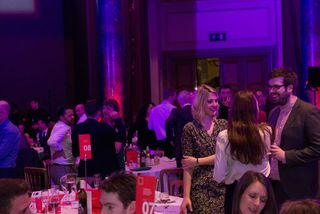How to create your best ever branding
Last year's Brand Impact Award winners share their golden secrets for designing outstanding branding.
But even on a more 'collaboration-lite' level like this, regular contact and communication is the foundation of a successful studio-client relationship. Finding the right channels of communication is key, Elliott points out.
There's no sense in expecting constant face-to-face meetings with clients on the other side of the world. But finding ways to engage them in the process at critical stages – via phone, email or Skype – is the best way to ensure success.
Nonetheless, where possible, face-to-face is still the preferred option for many. "There is no substitute," says Howat. "Especially when you are in the research and concept stages – you just can't get a feel for things if it's done remotely."
Careful planning is also essential, advises Hughes. "Avoid lots of shorter meetings and try to cover things in fewer longer meetings." It's also important for the branding agency to visit the client and get a feel for their business or organisation, and the environment they work in, she adds.
"But at the same time we also like our clients to feel at home in our studio. Many of our clients enjoy leaving their office and coming to the studio. It allows them to focus on the creative for a few hours without the distraction of their other projects and responsibilities.
Also, by leaving their place of work and coming to our studio they often find it easier to take a more objective approach to their projects."
For another triple Brand Impact Awards winner,R/GA London, collaborating successfully with a client is all about balancing the studio's and client's ways of working, according to Lucio Rufo, group creative director and head of visual. "Ultimately we don't want to impose a very rigid structure, and always try to be open to different approaches and ideas."
Get the Creative Bloq Newsletter
Daily design news, reviews, how-tos and more, as picked by the editors.

Many successful studio-client relationships are nurtured over years. Rose's relationship with Art on the Underground is "a good example of a client having the confidence and belief in us to fight for our ideas, within an enormous British public institution," says Elliott.
"[They] allow us to become genuine long-term partners, rather than suppliers, on their multi-award-winning projects."
But building a good collaboration from the start is important too, and a few common-sense tips can make this easier. "Learn to become good listeners," says Elliott.

"Equally, recognise that clients buy us for our experience, expertise and advice. But in order to offer or create anything of value to your client, you have to be able to stand in the shoes of your client's audience, to be able to connect with them."
When embarking on new client relationships, johnson banks often mentions the fact that it is a studio happy to be collaborative. "Then it depends rather on the client to 'pick up' on that cue," says Johnson.
"Some have entered the branding process looking for an 'external voice' and want to keep it that way. Others, once they find out that we're happy to 'share', as it were, become more energised by the process."
Pear-shaped projects
Despite the clear advantages of collaboration between studio and client, the relationship can sometimes turn sour, or communication can break down. For this reason, picking up on a potential downturn in relations can head off far bigger problems down the road.
For example, Johnson says that he has seen a few things go pear-shaped when a newish in-house team member sees a project as a chance to make their mark.
"One of our ex-collaborators merrily redesigned our whole scheme within a year and airbrushed us off the project," Johnson recalls. "That seemed a little extreme, but perhaps we should have seen that coming."
One collaboration warning sign for Howat is "when the client says they are too busy to talk to you at the beginning of the project". "If they don't engage at this stage, it's pretty unlikely it will work," he explains. "As soon as there is no dialogue, you know you are going to be in trouble."
In another scenario, a client might start to try and fix design problems with very specific, detailed instructions and amends, rather than telling an agency the problem and allowing the creative team to come up with the solution.

"This can be a sign of a lack of trust or confidence in the work," says Hughes. "If this starts to happen, try to go back to dealing in 'problems' and reassuring the client that you understand the issue and will come back to them with some solutions."
Sometimes, it might also be best to cut losses and exit a relationship. "Some clients start believing they don't need you as much as they once did," says Elliott, for example.
"Or that the level of quality – and resulting success – you have helped create can be achieved cheaper elsewhere. Sometimes you can turn this around. But generally, it's a sign that the dynamic in the relationship may be shifting, and that the trust and respect as key drivers in the relationship may be waning."
Elliot goes on: "When this happens (and it happens to all studios at some point, if you're in business long enough), we don't tend to fight it. Not when there are enough people who continue to recognise the value in what we do for them."
Pleasing everyone is impossible
In fact throughout the relationship, it's important to remember that "collaboration doesn't have to mean compromise," as Hughes points out. "Trying to please everyone is impossible and if you try to with a branding project you can end up with a very confused brand."
"By trying to please too many people, you may end up pleasing nobody. The key is understanding which audiences and stakeholders are your priority, who are the key people who we need to be communicating with."

Also, don't confuse client-studio collaboration with 'decision by committee', cautions Elliott. "They are entirely different things. Always agree on a single client contact if possible. Or a spokesperson who will consolidate and feedback group or committee comments as one voice."
Being extremely clear about people's roles and responsibilities, who is giving direction, especially in close collaborations where studio or client is embedded with the other, can also avoid a number of pitfalls. "Often things can fall in the gaps between parties," says Hewitt. "You have to be very clear about who's responsible for what."
After all, studios should see collaboration as a help, not a hindrance. Listen carefully to what a client says, advises Howat – "it's an underestimated skill."
But it's also worth remembering that clients want to be challenged. "That's what they have come to you for," says Hughes. "Don't tell clients what you think they want to hear, give them your honest, considered opinions. Be pro-active, don't wait to be asked."
Words: Anna Richardson Taylor
Illustration: Jose Miguel Mendez
The full version of this article appeared inside Computer Arts issue 239: Love Print/Love Digital, a special collector's item.
Have you entered your best branding to the 2015 Brand Impact Awards?

Enter the 2015 BIAs to join the likes of johnson banks, hat-trick and R/GA – all triple award winners in 2014 – as well as Rose and Coast, who scooped Best of Show awards
If you've created some outstanding branding in the last 18 months, you're eligible to enter the Brand Impact Awards.
They're judged by an elite panel of designers and client-side creatives from global brands like Coca-Cola, and aim to celebrate the industry's best branding across more than 20 different market sectors.
Beyond a stunning piece of design work, the judges are looking for consistency of application across various touchpoints. Work will be judged according to the market sector for which it was designed.
The deadline for entries is 18 June, 17:30 GMT. You can find out more about the Brand Impact Awards here, and enter your work today though the Brand Impact Awards website. Good luck!
Liked this? Try these...
- The ultimate guide to logo design
- How to build an app: try these great tutorials
- Free graphic design software available to you right now!

Thank you for reading 5 articles this month* Join now for unlimited access
Enjoy your first month for just £1 / $1 / €1
*Read 5 free articles per month without a subscription

Join now for unlimited access
Try first month for just £1 / $1 / €1
The Creative Bloq team is made up of a group of design fans, and has changed and evolved since Creative Bloq began back in 2012. The current website team consists of eight full-time members of staff: Editor Georgia Coggan, Deputy Editor Rosie Hilder, Ecommerce Editor Beren Neale, Senior News Editor Daniel Piper, Editor, Digital Art and 3D Ian Dean, Tech Reviews Editor Erlingur Einarsson and Ecommerce Writer Beth Nicholls and Staff Writer Natalie Fear, as well as a roster of freelancers from around the world. The 3D World and ImagineFX magazine teams also pitch in, ensuring that content from 3D World and ImagineFX is represented on Creative Bloq.
